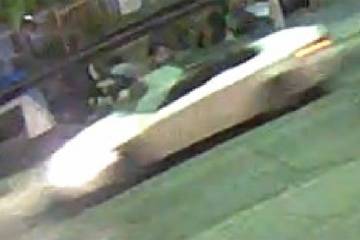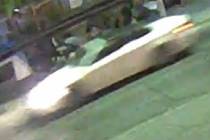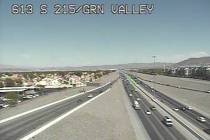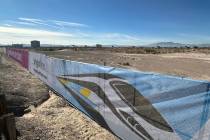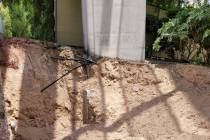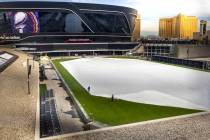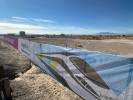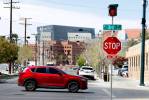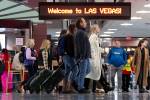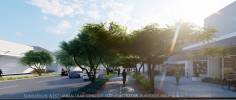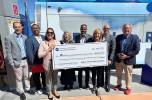XpressWest draws nominal high-speed rail competitors
When the Nevada High-Speed Rail Authority meets later this month to consider awarding a franchise for a system to deliver train passengers between Las Vegas and Southern California, there will be two competitors vying against the favorite, XpressWest.
Las Vegas-based XpressWest, formerly known as DesertXpress, has been the anticipated franchisee ever since Senate Bill 457 was signed into law earlier this year. The system requirements listed in the legislation match closely with those in the XpressWest business plan.
But the five-member authority is expected to hear presentations on each proposal Nov. 18, even though neither of the underdog competitors qualify based on the requirements of the legislation.
In addition to XpressWest, proposals will be offered by Sky Tram International, Portland, Ore.; and Las Vegas-based David Brough's Dual-Mode Advanced Vehicular Endeavor, known as D.A.V.E. There won't be a presentation on a third proposal, submitted by the Reno-based Nevada Intercity Passenger Railroad, headed by Lamar Aiazzi.
Aiazzi said he responded to a request for franchise proposals more as a protest than as a plan that would get serious consideration. While Aiazzi is working on a plan that would use traditional steel-wheels-on-rails technology, he's more interested in linking Northern Nevada with Southern Nevada, which he argues would be more beneficial to the state than a train between Las Vegas and Southern California. His plan also includes a Southern Nevada-Southern California component and that incorporating freight hauling into the project could generate investment from gaming and mining interests.
Aiazzi said Nevada Intercity intends to utilize graduate students from the University of Nevada, Las Vegas, and the University of Nevada, Reno, to design specific portions of the rail infrastructure and service.
"The university system's drone research facilities, the Desert Research Institute's Computational Research and Visualization system, the DRI's expertise in Nevada's desert environs, the mining and geology college's seismology sensors scattered statewide, UNLV's hospitality college are all important components in conducting the environmental impact statement, building it quickly, operating it safely and in a manner that insures customer loyalty," he said.
"Should the authority select XpressWest as its sole franchisee, all of that potential will be thrown away," he said.
Aiazzi isn't alone in his assessment that Senate Bill 457 legislates a stacked deck against competitors to XpressWest.
Brough advocates D.A.V.E., a high-speed personal rapid transit system that would mount standard-gauge tracks and an electrified rail atop a guideway accessible by cars and trucks fitted with flanges and grips that would enable conventional motor vehicles to speed along the rails.
"I'm very disappointed in my state legislators that they would stoop to this level by pushing a system that no one can compete with," Brough said, calling the process "a coronation of XpressWest."
Brough said his system is based on a 1923 patent and that it would have significantly greater capacity than the XpressWest plan and would enable people to use their own vehicles to move quickly between regions.
One other proposal the authority expects to hear considers an alternative technology.
Sky Tram, a green-power elevated, suspended monorail system capable of speeds of up to 250 mph, will be presented by Sky Tram President and CEO Ben Missler, a former Boeing electronics specialist.
Missler has been working on the project since 2006 and views plans under study in Nevada has the potential kickoff of a nationwide transportation system. His proposal would develop a line between Las Vegas and Glendale, Calif., with eventual feeder lines to Los Angeles and Anaheim. The propulsion system on the all-electric fast-charge vehicle would provide enough energy to climb steep Cajon Pass from the San Bernardino area. The vehicle is proposed as a recycled aircraft fuselage. Federal regulations require airframes to be retired over time, but since the Sky Tram would not have to be pressurized, refurbished aircraft fuselages could be used for the ground-transportation system.
Missler is aware of the struggle that developers of magnetic-levitation systems have had in developing a transportation system to Southern California and is undeterred that Senate Bill 457 would apparently disqualify his project.
"When Henry Ford asked people what they wanted for improved transportation, they would tell him they wanted a faster horse," Missler said in a Tuesday interview.
"If you ask people what they want for this, they'll say they want faster choo-choo trains," he said. "But that's 1800s technology. I used to love to ride trains, but they're outdated. It's like trying to drive Model T's on today's interstate highway system."
Missler said Sky Tram could be built for less than half the cost of the XpressWest proposal.
But there's still the legislative mandate to overcome.
Senate Bill 457 says the system under consideration by the authority board must be "capable of sustained speeds of at least 150 mph or the speed established by the U.S. Department of Transportation and the Federal Railroad Administration's plans and policies for high-speed rail express services; carry primarily passengers between Southern Nevada and Southern California; operate on dedicated and exclusive standard-gauge tracks for the purpose of high-speed rail service; allow for interoperability with existing and planned rail systems; and is certified or authorized by the Surface Transportation Board of the Department of Transportation as an interstate passenger railroad to construct and operate its route between Southern Nevada and Southern California."
Contact reporter Richard N. Velotta at rvelotta@reviewjournal.com or 702-477-3893. Find @RickVelotta on Twitter.






